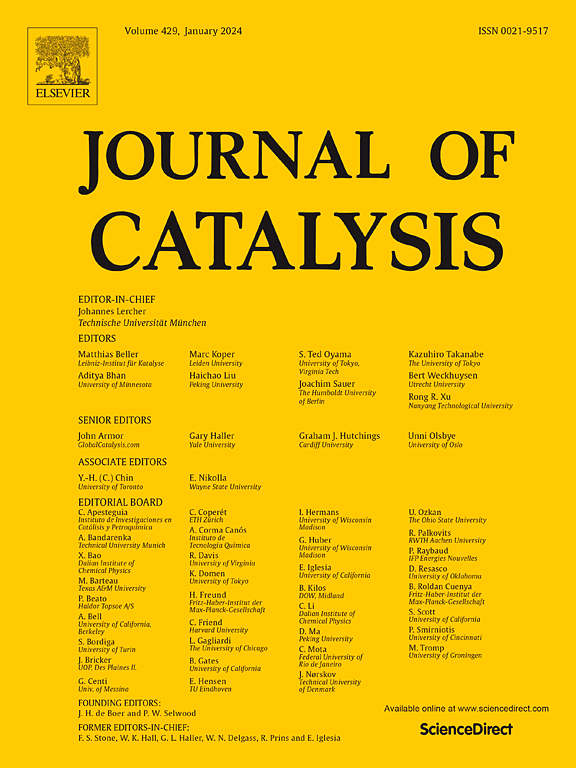Adsorption coupled metal/anion/oxide structure for synergistic synthesizing solketal from glycerol
IF 6.5
1区 化学
Q2 CHEMISTRY, PHYSICAL
引用次数: 0
Abstract
Although homogeneous acid catalysts have been widely utilized in the production of solketal from glycerol, a significant aspect of the biodiesel industry, challenges remain, including the high corrosiveness of the catalysts and their excessive usage. In this study, a composite material of wCo(NO3)2/γ-Al2O3 was synthesized through an adsorption–desorption approach based on wet impregnation, achieving a Co(II) loading of only 1.8 wt%, which demonstrated a solketal yield of 84 % at 80 °C, significantly outperforming the catalytic activity of Co(NO3)2. Even when the amount of Co(NO3)2 was increased to 22-fold that of the Co(II) content in wCo(NO3)2/γ-Al2O3, the solketal yield only reached 67 %. Through systematic physicochemical characterization and theoretical calculations, it is revealed that Co(NO3)2 can be uniformly dispersed in an amorphous state on the surface of γ-Al2O3. Furthermore, γ-Al2O3 facilitates a reduction in the orbital binding energy of Co and N within Co(NO3)2. The synergistic effects of Co(II), NO3−, and γ-Al2O3 contribute to decreasing the rate-determining energy of the ketalization reaction, thereby promoting the dehydration reactions of glycerol and acetone. Furthermore, this strategy is equally applicable to other soluble Co, Ni, and Cu salts, demonstrating universality. This method effectively reduces the usage of metal salts in the solketal synthesis process, enhancing the acid catalytic activity of the metal salts, providing an adsorption–desorption approach based on wet impregnation for the development of low-dose, highly active, and low-corrosive acid catalytic materials.


吸附偶联金属/阴离子/氧化物结构协同合成甘油溶胶
虽然均相酸催化剂已被广泛应用于从甘油中生产乙醇,这是生物柴油工业的一个重要方面,但仍然存在挑战,包括催化剂的高腐蚀性和过度使用。在本研究中,通过湿浸渍的吸附-解吸方法合成了wCo(NO3)2/γ-Al2O3复合材料,Co(II)负载仅为1.8 wt%,在80 °C下的溶剂收率为84 %,显著优于Co(NO3)2的催化活性。在wCo(NO3)2/γ-Al2O3中,Co(NO3)2的含量增加到Co(II)含量的22倍时,溶剂收率仅为67 %。通过系统的物理化学表征和理论计算,发现Co(NO3)2可以以非晶态均匀分散在γ-Al2O3表面。此外,γ-Al2O3有助于Co(NO3)2中Co和N的轨道结合能的降低。Co(II)、NO3−和γ-Al2O3的协同作用降低了烷基化反应的定速能,从而促进了甘油和丙酮的脱水反应。此外,该策略同样适用于其他可溶性Co, Ni和Cu盐,证明了普遍性。该方法有效减少了溶胶合成过程中金属盐的用量,提高了金属盐的酸催化活性,为开发低剂量、高活性、低腐蚀的酸催化材料提供了一种基于湿浸渍的吸附-解吸途径。
本文章由计算机程序翻译,如有差异,请以英文原文为准。
求助全文
约1分钟内获得全文
求助全文
来源期刊

Journal of Catalysis
工程技术-工程:化工
CiteScore
12.30
自引率
5.50%
发文量
447
审稿时长
31 days
期刊介绍:
The Journal of Catalysis publishes scholarly articles on both heterogeneous and homogeneous catalysis, covering a wide range of chemical transformations. These include various types of catalysis, such as those mediated by photons, plasmons, and electrons. The focus of the studies is to understand the relationship between catalytic function and the underlying chemical properties of surfaces and metal complexes.
The articles in the journal offer innovative concepts and explore the synthesis and kinetics of inorganic solids and homogeneous complexes. Furthermore, they discuss spectroscopic techniques for characterizing catalysts, investigate the interaction of probes and reacting species with catalysts, and employ theoretical methods.
The research presented in the journal should have direct relevance to the field of catalytic processes, addressing either fundamental aspects or applications of catalysis.
 求助内容:
求助内容: 应助结果提醒方式:
应助结果提醒方式:


